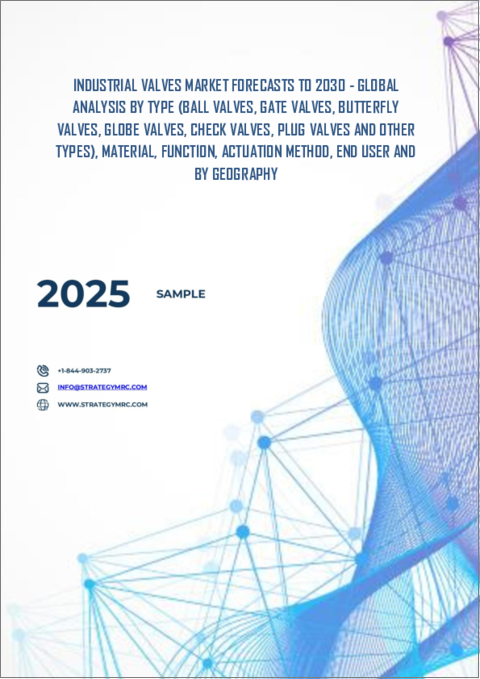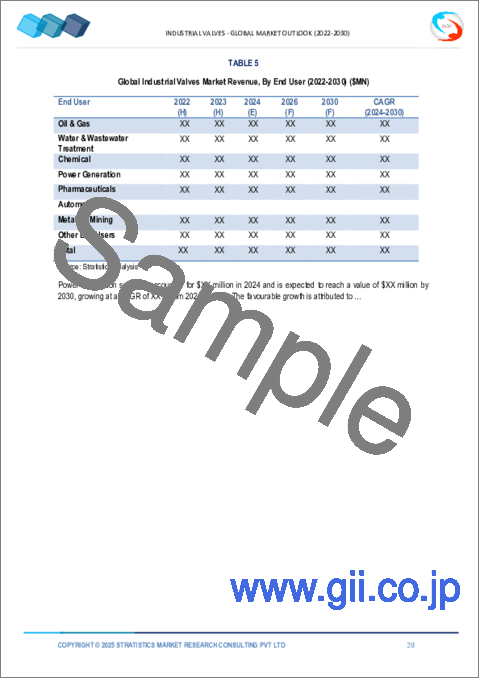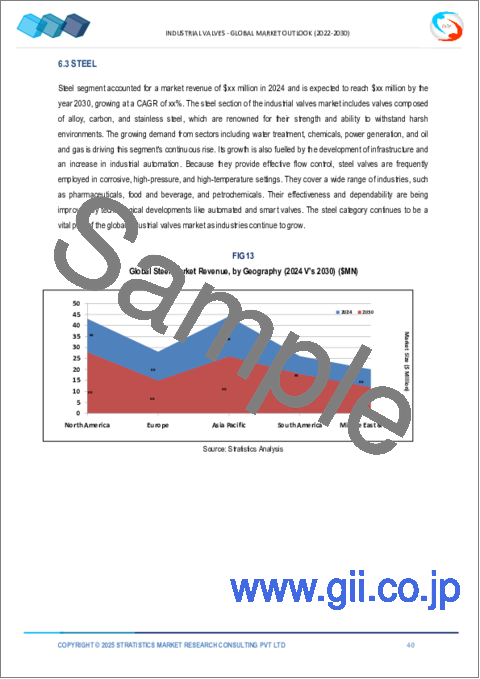|
|
市場調査レポート
商品コード
1494896
工業用バルブの2030年までの市場予測:タイプ、材料、機能、作動方法、エンドユーザー、地域別の世界分析Industrial Valves Market Forecasts to 2030 - Global Analysis By Type (Ball Valves, Gate Valves, Butterfly Valves, Globe Valves, Check Valves, Plug Valves and Other Types), Material, Function, Actuation Method, End User and By Geography |
||||||
カスタマイズ可能
|
|||||||
| 工業用バルブの2030年までの市場予測:タイプ、材料、機能、作動方法、エンドユーザー、地域別の世界分析 |
|
出版日: 2024年06月06日
発行: Stratistics Market Research Consulting
ページ情報: 英文 200+ Pages
納期: 2~3営業日
|
全表示
- 概要
- 図表
- 目次
Stratistics MRCによると、工業用バルブの世界市場は2024年に855億米ドルを占め、予測期間中のCAGRは6.4%で成長し、2030年には1,241億米ドルに達する見込みです。
工業用バルブは、配管システム内の流体(液体、気体、スラリー)の流れを調整するために使用される機械装置です。バルブは、システムを通過する流体の流量、圧力、温度、方向を制御することができます。バルブは、石油・ガス、水処理、化学処理、発電、製薬、製造など、様々な産業において不可欠な部品です。これらのバルブには様々なタイプがあり、それぞれが特定の用途や使用条件に合わせて設計されています。一般的な工業用バルブには、ゲートバルブ、グローブバルブ、ボールバルブ、バタフライバルブ、チェックバルブ、プラグバルブなどがあります。
インフラ整備への投資の増加
新興国市場では、開発を強化するためのインフラ投資が急増しています。この戦略的重点は、産業運営の効率と信頼性を高めることにあります。投資には、既存のインフラを近代化し、進化する需要に対応するための新しい施設を建設することが含まれます。このようなイニシアチブは、技術の進歩を促進するだけでなく、業界内の持続可能な慣行を促進します。
原材料価格の変動
市場は、原材料価格の変動による大きな課題に直面しています。このような変動は製造コストに影響を及ぼし、価格の不安定化やバルブメーカーの利益率低下の可能性につながります。石油・ガス、上下水道処理、化学処理など、工業用バルブに依存している業界は、こうした変動の影響を特に受けやすいです。リスクを軽減するために、企業は戦略的な調達戦術を採用したり、代替材料を探したり、価格戦略を調整したりして、市場環境の変化に適応する必要があるかもしれないです。
厳しい環境規制
市場は、原材料価格の変動による大きな課題に直面しています。このような変動は製造コストに影響を及ぼし、バルブメーカーにとっては価格の不安定化や利益率の低下の可能性につながります。石油・ガス、上下水道処理、化学処理など、工業用バルブに依存している業界は、こうした変動の影響を特に受けやすいです。リスクを軽減するために、企業は戦略的な調達戦術を採用したり、代替材料を探したり、価格戦略を調整して市場環境の変化に適応する必要があるかもしれません。
原材料価格の変動
鋼鉄、黄銅、様々な合金のような材料はバルブ生産に不可欠であり、その価格は世界の需要、サプライチェーンの混乱、地政学的な出来事などの要因によって影響を受ける可能性があります。このような変動は、バルブメーカーにとって、製品の品質を確保し市場の需要を満たしながら、競争力のある価格と収益性を維持するという課題をもたらします。効果的なサプライチェーンマネジメントと戦略的な調達戦略は、こうした価格変動を乗り切り、市場競争力を維持するために極めて重要です。
COVID-19の影響:
COVID-19の流行は工業用バルブ市場に大きな影響を与えました。サプライチェーンの混乱、プロジェクトの停止による需要の減少、労働力の制約が生産と販売の減少につながった。工業用バルブの主要消費者である石油・ガス、上下水道、発電などの業界は減速に見舞われました。しかし、ヘルスケア分野では、医療機器に使用されるバルブにビジネスチャンスがあった。産業が回復し、新たな規範に順応するにつれて、革新と回復力に焦点を当てた市場は徐々に回復すると予想されます。
予測期間中、バタフライバルブ分野が最大となる見込み
予測期間中、バタフライバルブが最大となる見込みです。バタフライバルブは、流線型のデザインと1/4回転の操作で、パイプライン内で金属ディスクを90度の角度で回転させることにより流体の流れを調整します。このメカニズムにより、迅速なシャットオフと正確な流量調節が可能となり、石油・ガス、水処理、化学処理、HVACシステムなどの産業でバタフライバルブが不可欠となっています。
予測期間中、化学分野のCAGRが最も高くなる見込み
予測期間中、CAGRが最も高くなると予測されているのは化学分野です。世界の工業化とインフラ整備の進展に伴い、効率的な流量制御機構のニーズが急増しています。化学的適合性、耐食性、耐久性は、バルブ製造におけるステンレス鋼、真鍮、合金のような特殊材料の採用を促進する主な考慮事項です。さらに、職場の安全や環境保護に関する厳しい規制も市場動向に影響を与えています。
最大のシェアを占める地域
予測期間中、北米が最大の市場シェアを占めると予測されます。バルブシステムにおけるIoTや自動化の統合などの技術的進歩が、市場拡大をさらに促進しています。さらに、安全性と環境に関する厳しい規制が、高品質バルブの需要を促進しています。この市場は、主要企業が製品革新と戦略的提携を重視する競合情勢を特徴としています。
CAGRが最も高い地域:
予測期間中、アジア太平洋地域が最も高いCAGRを維持すると予測されています。中国、インド、東南アジア諸国などの急速な工業化が、石油・ガス、上下水道治療、発電、化学、製造など様々な分野における工業用バルブの需要を促進しています。都市化の進展は上下水道インフラの拡大につながり、配水網や下水処理場で使用されるバルブの需要を生み出しています。
無料のカスタマイズサービス
本レポートをご購読のお客様には、以下の無料カスタマイズオプションのいずれかをご利用いただけます:
- 企業プロファイル
- 追加市場プレイヤーの包括的プロファイリング(3社まで)
- 主要企業のSWOT分析(3社まで)
- 地域セグメンテーション
- 顧客の関心に応じた主要国の市場推計・予測・CAGR(注:フィージビリティチェックによる)
- 競合ベンチマーキング
- 製品ポートフォリオ、地理的プレゼンス、戦略的提携に基づく主要企業のベンチマーキング
目次
第1章 エグゼクティブサマリー
第2章 序文
- 概要
- ステークホルダー
- 調査範囲
- 調査手法
- データマイニング
- データ分析
- データ検証
- 調査アプローチ
- 調査情報源
- 1次調査情報源
- 2次調査情報源
- 前提条件
第3章 市場動向分析
- 促進要因
- 抑制要因
- 機会
- 脅威
- エンドユーザー分析
- 新興市場
- COVID-19の影響
第4章 ポーターのファイブフォース分析
- 供給企業の交渉力
- 買い手の交渉力
- 代替品の脅威
- 新規参入業者の脅威
- 競争企業間の敵対関係
第5章 世界の工業用バルブ市場:タイプ別
- ボールバルブ
- ゲートバルブ
- バタフライバルブ
- グローブバルブ
- チェックバルブ
- プラグバルブ
- その他のタイプ
第6章 世界の工業用バルブ市場:材料別
- 鋳鉄
- 鋼鉄
- 合金
- 真鍮
- 青銅
第7章 世界の工業用バルブ市場:機能別
- オン/オフバルブ
- コントロールバルブ
- 安全弁
- 特殊バルブ
- 遮断弁
第8章 世界の工業用バルブ市場:作動方式別
- マニュアル
- 空気圧
- 油圧式
- 電気
第9章 世界の工業用バルブ市場:エンドユーザー別
- 石油ガス
- 水・廃水治療
- 化学薬品
- 発電
- 医薬品
- 自動車
- 金属・鉱業
- その他のエンドユーザー
第10章 世界の工業用バルブ市場:地域別
- 北米
- 米国
- カナダ
- メキシコ
- 欧州
- ドイツ
- 英国
- イタリア
- フランス
- スペイン
- その他欧州
- アジア太平洋地域
- 日本
- 中国
- インド
- オーストラリア
- ニュージーランド
- 韓国
- その他アジア太平洋地域
- 南米
- アルゼンチン
- ブラジル
- チリ
- その他南米
- 中東・アフリカ
- サウジアラビア
- アラブ首長国連邦
- カタール
- 南アフリカ
- その他中東とアフリカ
第11章 主な発展
- 契約、パートナーシップ、コラボレーション、合弁事業
- 買収と合併
- 新製品発売
- 事業拡大
- その他の主要戦略
第12章 企業プロファイリング
- Emerson Electric Co.
- Flowserve Corporation
- Cameron International
- Pentair plc
- Spirax Sarco Limited
- Samson AG
- Metso Corporation
- AVK Group
- Parker Hannifin Corporation
- Danfoss A/S
- Alfa Laval AB
- Schneider Electric SE
- Curtiss-Wright Corp
- KITZ Corporation
- CIRCOR International, Inc.
- Beijer Tech
- Tecnik Fluid Controls
List of Tables
- Table 1 Global Industrial Valves Market Outlook, By Region (2022-2030) ($MN)
- Table 2 Global Industrial Valves Market Outlook, By Type (2022-2030) ($MN)
- Table 3 Global Industrial Valves Market Outlook, By Ball Valves (2022-2030) ($MN)
- Table 4 Global Industrial Valves Market Outlook, By Gate Valves (2022-2030) ($MN)
- Table 5 Global Industrial Valves Market Outlook, By Butterfly Valves (2022-2030) ($MN)
- Table 6 Global Industrial Valves Market Outlook, By Globe Valves (2022-2030) ($MN)
- Table 7 Global Industrial Valves Market Outlook, By Check Valves (2022-2030) ($MN)
- Table 8 Global Industrial Valves Market Outlook, By Plug Valves (2022-2030) ($MN)
- Table 9 Global Industrial Valves Market Outlook, By Other Types (2022-2030) ($MN)
- Table 10 Global Industrial Valves Market Outlook, By Material (2022-2030) ($MN)
- Table 11 Global Industrial Valves Market Outlook, By Cast Iron (2022-2030) ($MN)
- Table 12 Global Industrial Valves Market Outlook, By Steel (2022-2030) ($MN)
- Table 13 Global Industrial Valves Market Outlook, By Alloy (2022-2030) ($MN)
- Table 14 Global Industrial Valves Market Outlook, By Brass (2022-2030) ($MN)
- Table 15 Global Industrial Valves Market Outlook, By Bronze (2022-2030) ($MN)
- Table 16 Global Industrial Valves Market Outlook, By Function (2022-2030) ($MN)
- Table 17 Global Industrial Valves Market Outlook, By On/Off Valves (2022-2030) ($MN)
- Table 18 Global Industrial Valves Market Outlook, By Control Valves (2022-2030) ($MN)
- Table 19 Global Industrial Valves Market Outlook, By Safety Valves (2022-2030) ($MN)
- Table 20 Global Industrial Valves Market Outlook, By Specialty Valves (2022-2030) ($MN)
- Table 21 Global Industrial Valves Market Outlook, By Isolation Valves (2022-2030) ($MN)
- Table 22 Global Industrial Valves Market Outlook, By Actuation Method (2022-2030) ($MN)
- Table 23 Global Industrial Valves Market Outlook, By Manual (2022-2030) ($MN)
- Table 24 Global Industrial Valves Market Outlook, By Pneumatic (2022-2030) ($MN)
- Table 25 Global Industrial Valves Market Outlook, By Hydraulic (2022-2030) ($MN)
- Table 26 Global Industrial Valves Market Outlook, By Electric (2022-2030) ($MN)
- Table 27 Global Industrial Valves Market Outlook, By End User (2022-2030) ($MN)
- Table 28 Global Industrial Valves Market Outlook, By Oil & Gas (2022-2030) ($MN)
- Table 29 Global Industrial Valves Market Outlook, By Water & Wastewater Treatment (2022-2030) ($MN)
- Table 30 Global Industrial Valves Market Outlook, By Chemical (2022-2030) ($MN)
- Table 31 Global Industrial Valves Market Outlook, By Power Generation (2022-2030) ($MN)
- Table 32 Global Industrial Valves Market Outlook, By Pharmaceuticals (2022-2030) ($MN)
- Table 33 Global Industrial Valves Market Outlook, By Automotive (2022-2030) ($MN)
- Table 34 Global Industrial Valves Market Outlook, By Metals & Mining (2022-2030) ($MN)
- Table 35 Global Industrial Valves Market Outlook, By Other End Users (2022-2030) ($MN)
Note: Tables for North America, Europe, APAC, South America, and Middle East & Africa Regions are also represented in the same manner as above.
According to Stratistics MRC, the Global Industrial Valves Market is accounted for $85.5 billion in 2024 and is expected to reach $124.1 billion by 2030 growing at a CAGR of 6.4% during the forecast period. Industrial valves are mechanical devices used to regulate the flow of fluids (liquids, gases, or slurries) within a piping system. They can control the flow rate, pressure, temperature, and direction of the fluid passing through the system. Valves are essential components in various industries, including oil and gas, water treatment, chemical processing, power generation, pharmaceuticals, and manufacturing. These valves come in various types, each designed for specific applications and operating conditions. Some common types of industrial valves include gate valves, globe valves, ball valves, butterfly valves, check valves, and plug valves.
Market Dynamics:
Driver:
Increasing investment in infrastructure development
The market is witnessing a surge in infrastructure investment to bolster development. This strategic focus aims to enhance the efficiency and reliability of industrial operations. Investments encompass modernizing existing infrastructure and constructing new facilities to meet evolving demands. Such initiatives not only drive technological advancements but also foster sustainable practices within the industry
Restraint:
Fluctuations in raw material prices
The market faces significant challenges due to fluctuations in raw material prices. These fluctuations can impact manufacturing costs, leading to price instability and potential profit margin erosion for valve manufacturers. Industries reliant on industrial valves, such as oil and gas, water and wastewater treatment, and chemical processing, are particularly vulnerable to these fluctuations. To mitigate risks, companies may need to employ strategic sourcing tactics, explore alternative materials, or adjust pricing strategies to adapt to changing market conditions.
Opportunity:
Stringent environmental regulations
The market faces significant challenges due to fluctuations in raw material prices. These fluctuations can impact manufacturing costs, leading to price instability and potential profit margin erosion for valve manufacturers. Industries reliant on industrial valves, such as oil and gas, water and wastewater treatment, and chemical processing, are particularly vulnerable to these fluctuations. To mitigate risks, companies may need to employ strategic sourcing tactics, explore alternative materials, or adjust pricing strategies to adapt to changing market conditions.
Threat:
Fluctuations in raw material prices
Materials like steel, brass, and various alloys are integral to valve production, and their prices can be influenced by factors such as global demand, supply chain disruptions, and geopolitical events. These fluctuations pose challenges for valve manufacturers in maintaining competitive pricing and profitability while ensuring product quality and meeting market demand. Effective supply chain management and strategic procurement strategies are crucial for navigating these price fluctuations and sustaining market competitiveness.
Covid-19 Impact:
The COVID-19 pandemic significantly impacted the Industrial Valves Market. Supply chain disruptions, reduced demand due to halted projects, and workforce constraints led to a decline in production and sales. Industries like oil and gas, water and wastewater, and power generation, major consumers of industrial valves, experienced slowdowns. However, the market also saw opportunities in the healthcare sector for valves used in medical equipment. As industries recover and adapt to new norms, the market is expected to gradually rebound with a focus on innovation and resilience.
The butterfly valves segment is expected to be the largest during the forecast period
The butterfly valves is expected to be the largest during the forecast period. With their streamlined design and quarter-turn operation, they regulate fluid flow by rotating a metal disc through a 90-degree angle within the pipeline. This mechanism allows for quick shutoff and precise flow modulation, making butterfly valves indispensable in industries such as oil and gas, water treatment, chemical processing, and HVAC systems.
The chemical segment is expected to have the highest CAGR during the forecast period
The chemical segment is expected to have the highest CAGR during the forecast period. With growing industrialization and infrastructure development globally, the need for efficient flow control mechanisms has surged. Chemical compatibility, corrosion resistance, and durability are key considerations driving the adoption of specialized materials like stainless steel, brass, and alloys in valve manufacturing. Additionally, stringent regulations regarding workplace safety and environmental protection further influence market trends.
Region with largest share:
North America is projected to hold the largest market share during the forecast period. Technological advancements, such as the integration of IoT and automation in valve systems, are further propelling market expansion. Additionally, stringent regulations regarding safety and environmental concerns are fostering the demand for high-quality valves. This market is characterized by a competitive landscape with key players emphasizing product innovation and strategic collaborations.
Region with highest CAGR:
Asia Pacific is projected to hold the highest CAGR over the forecast period. The rapid industrialization in countries like China, India, and Southeast Asian nations has been driving the demand for industrial valves across various sectors such as oil and gas, water and wastewater treatment, power generation, chemicals, and manufacturing. Increasing urbanization has led to the expansion of water and wastewater infrastructure, creating demand for valves used in water distribution networks and sewage treatment plants.
Key players in the market
Some of the key players in Industrial Valves market include Emerson Electric Co., Flowserve Corporation, Cameron International, Pentair plc, Spirax Sarco Limited, Samson AG, Metso Corporation, AVK Group, Parker Hannifin Corporation, Danfoss A/S, Alfa Laval AB, Schneider Electric SE, Curtiss-Wright Corp, KITZ Corporation, CIRCOR International, Inc., Beijer Tech and Tecnik Fluid Controls.
Key Developments:
In February 2024, Beijer Tech, a subsidiary of Beijer Alma, agreed to acquire 100% of AVS Power Oy, a Finnish technical wholesaler and manufacturer of pneumatics, industrial valves, and compressors. The acquisition aligns with Beijer Alma's value-adding strategy and is expected to boost earnings per share slightly.
In November 2023, Tecnik Fluid Controls formed a joint venture with United States-based ITT Industries Inc. to manufacture industrial valves for the pharmaceutical industry in India. ITT invested in the project and transferred the necessary technology.
Types Covered:
- Ball Valves
- Gate Valves
- Butterfly Valves
- Globe Valves
- Check Valves
- Plug Valves
- Other Types
Materials Covered:
- Cast Iron
- Steel
- Alloy
- Brass
- Bronze
Functions Covered:
- On/Off Valves
- Control Valves
- Safety Valves
- Specialty Valves
- Isolation Valves
Actuation Methods Covered:
- Manual
- Pneumatic
- Hydraulic
- Electric
End Users Covered:
- Oil & Gas
- Water & Wastewater Treatment
- Chemical
- Power Generation
- Pharmaceuticals
- Automotive
- Metals & Mining
- Other End Users
Regions Covered:
- North America
- US
- Canada
- Mexico
- Europe
- Germany
- UK
- Italy
- France
- Spain
- Rest of Europe
- Asia Pacific
- Japan
- China
- India
- Australia
- New Zealand
- South Korea
- Rest of Asia Pacific
- South America
- Argentina
- Brazil
- Chile
- Rest of South America
- Middle East & Africa
- Saudi Arabia
- UAE
- Qatar
- South Africa
- Rest of Middle East & Africa
What our report offers:
- Market share assessments for the regional and country-level segments
- Strategic recommendations for the new entrants
- Covers Market data for the years 2022, 2023, 2024, 2026, and 2030
- Market Trends (Drivers, Constraints, Opportunities, Threats, Challenges, Investment Opportunities, and recommendations)
- Strategic recommendations in key business segments based on the market estimations
- Competitive landscaping mapping the key common trends
- Company profiling with detailed strategies, financials, and recent developments
- Supply chain trends mapping the latest technological advancements
Free Customization Offerings:
All the customers of this report will be entitled to receive one of the following free customization options:
- Company Profiling
- Comprehensive profiling of additional market players (up to 3)
- SWOT Analysis of key players (up to 3)
- Regional Segmentation
- Market estimations, Forecasts and CAGR of any prominent country as per the client's interest (Note: Depends on feasibility check)
- Competitive Benchmarking
- Benchmarking of key players based on product portfolio, geographical presence, and strategic alliances
Table of Contents
1 Executive Summary
2 Preface
- 2.1 Abstract
- 2.2 Stake Holders
- 2.3 Research Scope
- 2.4 Research Methodology
- 2.4.1 Data Mining
- 2.4.2 Data Analysis
- 2.4.3 Data Validation
- 2.4.4 Research Approach
- 2.5 Research Sources
- 2.5.1 Primary Research Sources
- 2.5.2 Secondary Research Sources
- 2.5.3 Assumptions
3 Market Trend Analysis
- 3.1 Introduction
- 3.2 Drivers
- 3.3 Restraints
- 3.4 Opportunities
- 3.5 Threats
- 3.6 End User Analysis
- 3.7 Emerging Markets
- 3.8 Impact of Covid-19
4 Porters Five Force Analysis
- 4.1 Bargaining power of suppliers
- 4.2 Bargaining power of buyers
- 4.3 Threat of substitutes
- 4.4 Threat of new entrants
- 4.5 Competitive rivalry
5 Global Industrial Valves Market, By Type
- 5.1 Introduction
- 5.2 Ball Valves
- 5.3 Gate Valves
- 5.4 Butterfly Valves
- 5.5 Globe Valves
- 5.6 Check Valves
- 5.7 Plug Valves
- 5.8 Other Types
6 Global Industrial Valves Market, By Material
- 6.1 Introduction
- 6.2 Cast Iron
- 6.3 Steel
- 6.4 Alloy
- 6.5 Brass
- 6.6 Bronze
7 Global Industrial Valves Market, By Function
- 7.1 Introduction
- 7.2 On/Off Valves
- 7.3 Control Valves
- 7.4 Safety Valves
- 7.5 Specialty Valves
- 7.6 Isolation Valves
8 Global Industrial Valves Market, By Actuation Method
- 8.1 Introduction
- 8.2 Manual
- 8.3 Pneumatic
- 8.4 Hydraulic
- 8.5 Electric
9 Global Industrial Valves Market, By End User
- 9.1 Introduction
- 9.2 Oil & Gas
- 9.3 Water & Wastewater Treatment
- 9.4 Chemical
- 9.5 Power Generation
- 9.6 Pharmaceuticals
- 9.7 Automotive
- 9.8 Metals & Mining
- 9.9 Other End Users
10 Global Industrial Valves Market, By Geography
- 10.1 Introduction
- 10.2 North America
- 10.2.1 US
- 10.2.2 Canada
- 10.2.3 Mexico
- 10.3 Europe
- 10.3.1 Germany
- 10.3.2 UK
- 10.3.3 Italy
- 10.3.4 France
- 10.3.5 Spain
- 10.3.6 Rest of Europe
- 10.4 Asia Pacific
- 10.4.1 Japan
- 10.4.2 China
- 10.4.3 India
- 10.4.4 Australia
- 10.4.5 New Zealand
- 10.4.6 South Korea
- 10.4.7 Rest of Asia Pacific
- 10.5 South America
- 10.5.1 Argentina
- 10.5.2 Brazil
- 10.5.3 Chile
- 10.5.4 Rest of South America
- 10.6 Middle East & Africa
- 10.6.1 Saudi Arabia
- 10.6.2 UAE
- 10.6.3 Qatar
- 10.6.4 South Africa
- 10.6.5 Rest of Middle East & Africa
11 Key Developments
- 11.1 Agreements, Partnerships, Collaborations and Joint Ventures
- 11.2 Acquisitions & Mergers
- 11.3 New Product Launch
- 11.4 Expansions
- 11.5 Other Key Strategies
12 Company Profiling
- 12.1 Emerson Electric Co.
- 12.2 Flowserve Corporation
- 12.3 Cameron International
- 12.4 Pentair plc
- 12.5 Spirax Sarco Limited
- 12.6 Samson AG
- 12.7 Metso Corporation
- 12.8 AVK Group
- 12.9 Parker Hannifin Corporation
- 12.10 Danfoss A/S
- 12.11 Alfa Laval AB
- 12.12 Schneider Electric SE
- 12.13 Curtiss-Wright Corp
- 12.14 KITZ Corporation
- 12.15 CIRCOR International, Inc.
- 12.16 Beijer Tech
- 12.17 Tecnik Fluid Controls






